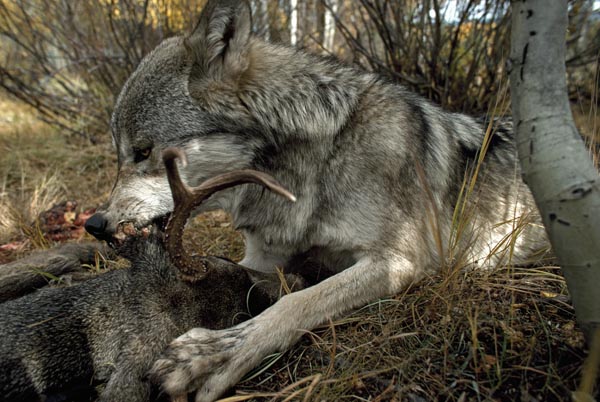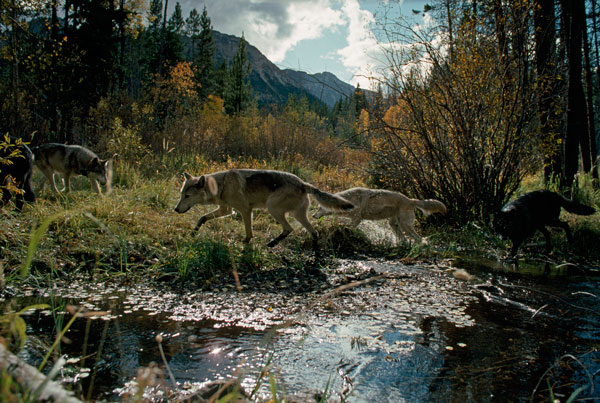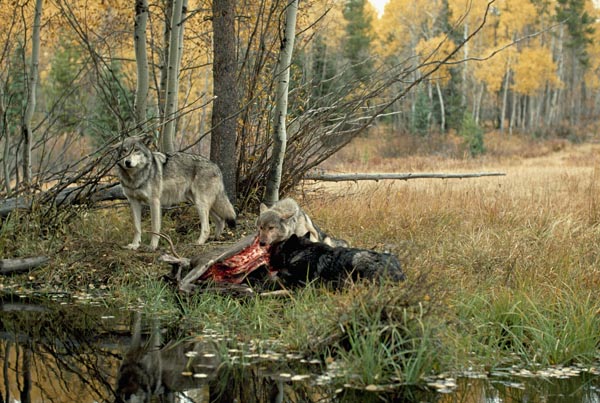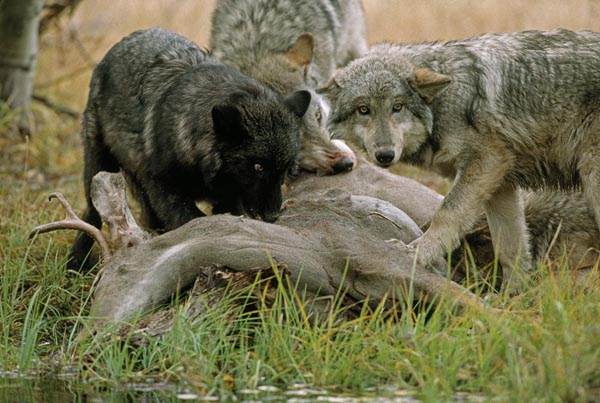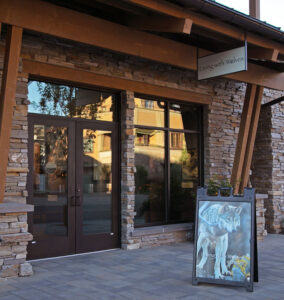What the wolf lacks in size, power and weapons it makes up for with collaboration and intelligence. Smaller and less powerful than mountain lions, for example, wolves work together to take down prey much larger than an individual wolf; prey that may otherwise elude them. While individual wolves have been able to subdue large prey animals, their advantage is in collaborating with their pack.
Wolves are opportunists. They test their prey, sensing any weakness or vulnerability through visual cues and even through hearing and scent. Contrary to ambush predators that rely on the element of surprise and a short and intense burst of energy to secure their prey, wolves are endurance or coursing predators. They chase their prey, often over longer distances, sometimes even a few miles, in order to find the right animal or opportunity. On the hunt, wolves work together with certain individuals typically carrying out their specific role in the hunt, often based on age, gender and social standing.
While wolves will eat hares and other small prey, their preferred targets are ungulates, large hoofed animals such as deer and elk. Individual packs will specialize in hunting specific prey species. While most often that is elk, caribou, deer and moose, it can also be bison, muskoxen, dall sheep or even salmon.
It is not uncommon for wolves to be injured or even killed during the hunt by being kicked by a hoof or gored by an antler. Most often the prey they select is in some way weaker and/or more vulnerable than the other animals in the herd. They may be injured, sick, old, very young or genetically inferior. But even healthier animals can at times find themselves in a vulnerable position. Over time this process allows the most capable prey animals to survive and pass on their genes and it helps to limit the spread of diseases within the herd. This is an ancient evolutionary success story shared by both predator and prey.
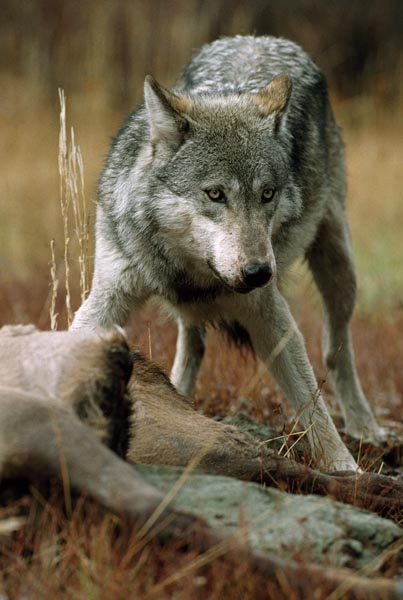
On the Hunt
It is during a hunt where co-operation between wolves within a pack is most apparent. A wolf pack may trail a herd of elk, caribou or other large prey for days before making its move. During this time, they are already hunting, assessing the herd, looking for an animal that displays any sign of weakness, and this is just the beginning. Wolves must also factor in other conditions that will affect the hunt; weather and terrain can tip the scales in favor of predator or prey. For example, a wide-open plain favors the ungulates, who, if full-grown and healthy, can outrun the fastest wolf. On the other hand, crusty snow or ice favors the wolves whose wide round paws have evolved to perform like snowshoes and carry them effortlessly over the surface. An experienced wolf is well aware that hoofed animals break through the crust and can become bogged down in deep snow.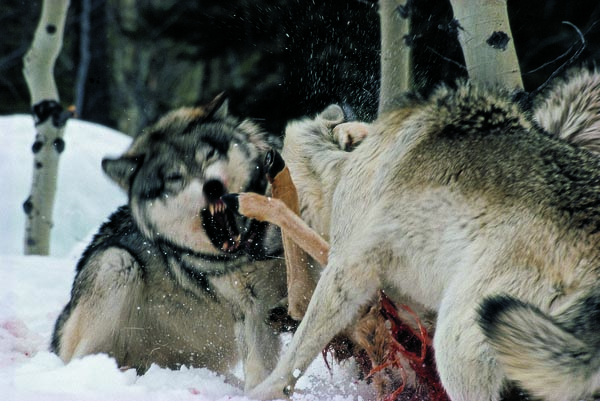
Wolves have learned to use these conditions to their advantage. The late wolf biologist, Dr. Gordon Haber speaks of a particular pack in Alaska that he observed following a herd of caribou on a narrow packed trail through deep snow. The wolves know that their mere presence, following close behind, will eventually panic the caribou. When the rearmost caribou spooks, leaving the hard trail and attempting to run to the middle of the herd, it founders in the snowdrifts. When that happens it is all over. In warm weather, this same pack of wolves changes its tactics, herding the caribou into a dry riverbed where many of the ungulates stumble on the round stones.
A wolf pack therefore weighs many different factors when selecting its target and, as circumstances change during the hunt the target may change as well. Initially they may be pursuing a calf, but if a big healthy bull stumbles unexpectedly, they all know to go after the bigger meal. Conversely, if too many factors seem to favor the prey, they may choose to wait. Sometimes it is better to stay a bit hungry until the odds improve rather than expend precious energy on a fruitless chase.
Other observers of wolves have reported that often fewer than half of wolves on a hunt are actually involved with physically bringing down the prey. The youngest wolves frequently do nothing more than observe and learn from the sidelines. Each of the other pack members contributes according to its particular experience and ability. Speedy, lightly built females often take on herding roles, darting back and forth in front of prey, causing confusion and preventing escape. Slower but more powerful males are able to take down a large animal more aggressively and quickly.
Some of the wolf’s bad reputation stems from the apparent mob scene that ensues when the prey begins to falter. Wolves are not equipped to dispatch their victims quickly; prey usually die of shock, muscle damage or blood loss. If it can, one of the stronger wolves will seize the prey by the nose and hold on tight, helping to bring about a more expeditious end, but the animal can still take many minutes before it succumbs. Equipped only with feet for running and jaws for biting, wolves make the best of their limitations. A wolf pack’s ferocity and apparent brutality is really a defensive measure. It is not rare for a wolf to be seriously injured by flailing hooves and slashing antlers. A well-placed kick could break a wolf’s jaw, rendering it unable to feed itself. It is much safer to harass the prey and let it tire out before moving in close. Far from being a mob scene, a hunt is a masterfully coordinated group effort, well deserving of our admiration.
Although the alpha male is usually in the thick of the hunt, it would be an exaggeration to say that he is leading it. The alpha may select the animal to be pursued, or he may chose to break off the hunt if it is going poorly. But he is not barking out orders to his subordinates like a general on the battlefield. The wolves just seem to know what to do, and they do it as one.
The young wolves watch the behavior of the adults and see how the game is played. They witness how the adults change their strategy according to conditions and type of prey. They learn how the hunters handle each different situation: what to do when the prey dashes for open ground, or jumps into a river, or turns to defend itself.
When juvenile wolves finally join in the hunt, they imitate the more experienced wolves and perfect the precise skills of herding and tackling. By the time they are full grown adults, they have become part of a well-oiled machine. Even if they were able to communicate verbally with each other during the hunt, it would be unnecessary. They know exactly what to expect from the others and what is expected of them.

